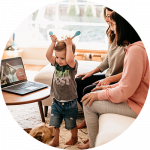
A few months ago, the global coronavirus pandemic found millions moving much of their lives online: e-learning, Facebook Live yoga, Zoom family get-togethers. During this time of immense change, one thing remains a constant: the importance of music. Whether it’s neighbors singing together from their balconies or televised sing-alongs of childhood favorites, music connects us like nothing else. It gives us a way to express our emotions. It makes us feel human.
For more than thirty years, we’ve been doing our part to make the world more musical. Rooted in research in early childhood development, Music Together classes have introduced music to millions of children across the globe. This spring, when it became clear that in-person classes would be on hold for some time, Music Together Online (MTO) was launched so we could continue to empower parents to make music a part of daily family life.
To find out more about the new program, we recently sat down for a conversation with Music Together Worldwide CEO Susan Darrow.
Question (Q): Did you ever think of offering MTO before this year?
Susan Darrow, Music Together Worldwide CEO (SD): The idea of offering online classes has come up from time to time through the years, but we always resisted due to guidance about screen time from the American Academy of Pediatrics, and because, as child development experts, we know that in-person music-making experiences are best for children. What’s changed, of course, is that in-person classes are not possible right now. But families still need us! So we decided to create an online program that meets the rigorous educational standards parents have come to expect from Music Together.
Q: How did these concerns impact the development of MTO?
SD: From the beginning, we wanted to be sure to create something that was interactive for the whole family. We knew we didn’t want the child to just sit in front of a screen and watch. We were not looking to create a passive screen time experience that was more about entertainment than education. There are a lot of entertainment options out there for those times when parents just need a break. But, that’s not who we are. We knew that in order to make it truly interactive, parent participation in class would be vital, just as it is during our in-person classes.
Q: Why is it so important for parents to participate in class?
SD: Parent involvement is the key to children’s music development, especially when they’re young. That’s the “Together” part of “Music Together”: It’s the parent and child! Young children learn best from someone they love, not a teacher they only see once a week. Music that happens once a week is fun. Music that happens every day, that’s music education. The teacher’s job in any Music Together class, online or in person, is to show parents how to engage musically with their child during class, and model how to be a musical parent when class isn’t happening.
Q: What if a parent is worried about not being a great singer or dancer?
SD: I have good news on that front! It doesn’t matter how well you sing or dance, it only matters that you do it. Your children don’t learn how to sing from you, they learn to sing. So, if you have fun playing with music, your child will learn to love it too. It’s really that simple!
Q: How are MTO teachers trained?
SD: Before teaching any Music Together class, teachers are required to pass our comprehensive Teacher Training, which focuses on how children develop musically. We have added training modules to support MTO, but because our teaching principles are rooted in child development, the overall approach is very similar. We teach the way young children learn—we follow their lead, we don’t pressure them to perform in any way, and, most importantly, we teach through play. All that remains the same, whether they are in a living room or a studio classroom.
Q: Have you had to adapt your teaching techniques given this new medium?
SD: One difference has to do with very young children and screen time. With infants, the recommendation from the experts is no screen time at all. So, when we do classes with very young babies, we ask the parents to turn their children around so they are facing the parent and can’t see the screen at all. The parent watches the teacher and follows what the teacher is doing and the baby is entirely focused on watching Mom or Dad, not the screen.
Q: If parents want to learn more about the developmental approach to learning, do you have any suggestions on where they can look?
SD: The National Association for the Education of Young Children (NAEYC) is a great resource for more on young children and learning. For more about how young children learn music, we’re the resource! (Check out the blog on musictogether.com or, if you’re enrolled in class, the resources on the Family Music Zone.)
Q: Have you heard anything from the families enrolled in MTO that you’d like the share?
SD: The initial feedback from families has been overwhelmingly positive. In this incredible time of uncertainty, I think, for families that have taken a Music Together class before, they like having something familiar: a teacher they know, song activities that they recognize . . . it feels comforting. We know that all parents are looking for experiences that are interactive, educational, and fun—and we’re happy that we now have a great option for them!



